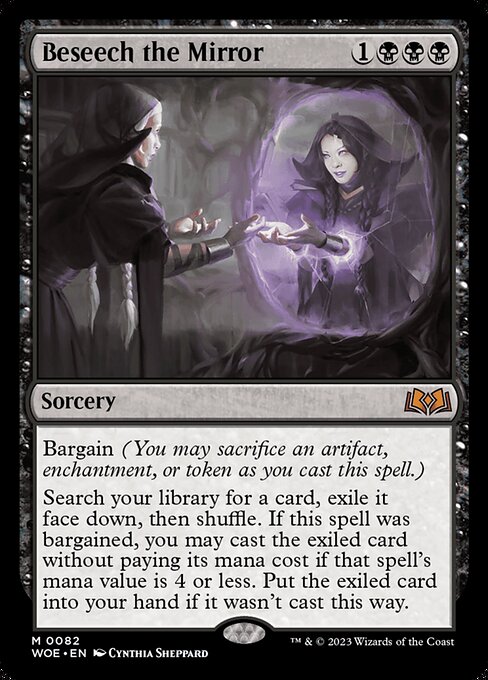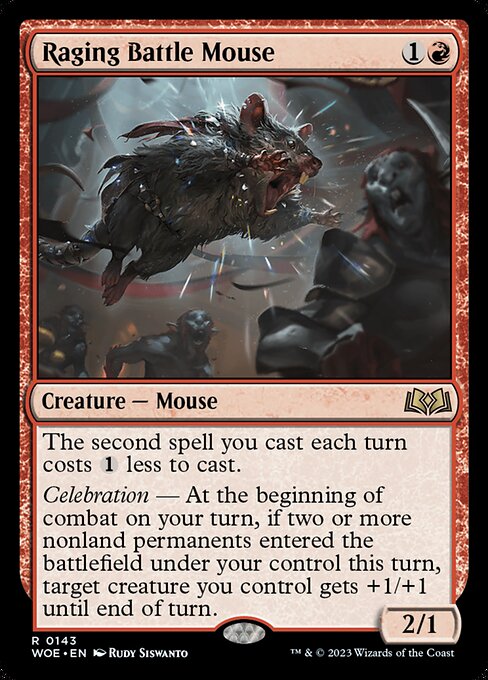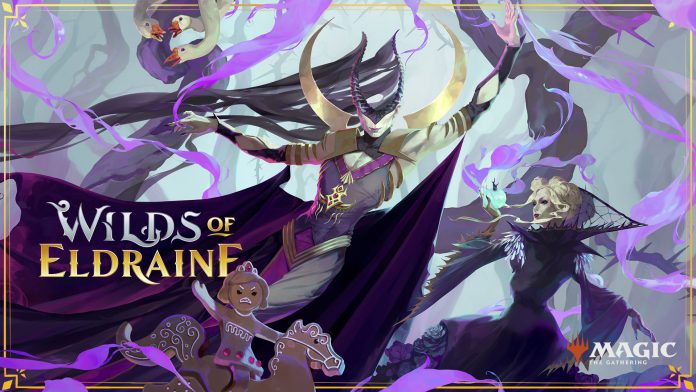The Phyrexians have been defeated, but a new problem has arisen in the plane of Eldraine. The curse known as the Wicked Slumber threatens to spread across the realm as the newly desparked Wil and Rowan fight to stop it and save their kingdom. A new set means new mechanics, and we’re kicking off our review with a breakdown of the mechanics and their implications.
Role Tokens

There are seven role tokens, six in the main set and a seventh only for Commander.
- Cursed — Enchanted creature has base power and toughness 1/1.
- Monster — Enchanted creature gets +1/+1 and has trample.
- Royal — Enchanted creature gets +1/+1 and has ward {1}.
- Sorcerer — Enchanted creature gets +1/+1 and has “Whenever this creature attacks, scry 1.”
- Wicked — Enchanted creature gets +1/+1 and “When this Aura is put into a graveyard from the battlefield, each opponent loses 1 life.”
- Young Hero — Enchanted creature has “Whenever this creature attacks, if its toughness is 3 or less, put a +1/+1 counter on it.”
- (Commander) Virtuous — Enchanted creature gets +1/+1 for each enchantment you control.
Up till now enchantment tokens have been fairly rare, either coming from the ability to copy any permanent or copy a spell thus creating a token permanent, or a few creatures that created creature enchantment tokens, or a couple of planeswalkers. What’s even more rare about these tokens is they are specifically auras. Most of these are being created by creature ETBs, and the limit of only having 1 role controlled by a player creatures a hard limit on this getting out of control. This means putting a cursed role onto an opponents creature will generate an artifact ETB. It also means in theory a creature could have as many as 4 roles, though as only one of the roles is really a debuff.
I think these are a solid and fun mechanic that isn’t particularly overpowered but also leads to some potentially nice political horse trading in a Commander game.
Bargain

If you sacrifice an artifact, enchantment, or token as you cast this spell, it does something extra. So this is one of the most returned to Magic mechanics – kicker with another name. Still it’s a decent ability, and can be leveraged with things that care about sacrifice or things going to the graveyard or even as a way to get rid of troublesome permanents, things like Demonic Lore. You also can cast a spell with bargain in response to one of your appropriate permanents being targeted and sacrifice it in response. It’s hard to tell how good this will be, it just depends on how basically powerful all the bargain cards are, but some of them are sure to be decent enough to be worth playing, and then they just have upside. It’s also good for cards like, well, Mayhem Devil, which is straight up a crazy good card anyway. It does unfortunately mean if your spell doesn’t resolve (i.e. is countered or otherwise removed from the stack) you’ve lost the sacrifice.
Celebration

Essentially celebration is a get a benefit if “two or more nonland permanents entered the battlefield under your control this turn ” and the benefit varies. This is gonna be really strong for cantrip creature type decks and decks that run lots of cheap permanents, if there is also a mechanic to keep up that rate of card playing. There’s also the possibility of triggered Treasure or Clue creation, stuff like that to create nonland permanents. So far the benefits from celebration don’t seem that significant for Commander, and so this will probably be a lot more impactful in 4-of settings. It also depends on if it is all enters the battlefield effects or if any are on enchantments or something like that, and potentially triggerable on each of your opponent’s turns in Commander (i.e. off something gross already like a Smothering Tithe).
Returning Mechanics
Adventures
Adventure returns, this was a popular flexible mechanic that got a bit crazy for a while with Prosperous Innkeeper and Lucky Clover letting you get a lot of value out of your adventures and then turn them into creatures. A few were really strong, like the Bonecrusher Giant but the adventures look slightly dialed back with some really well thought out paired mechanics.
It’s cool to see them are back as a popular mechanic with a new twist, multi-color adventures (as in the adventure is one color, the creature another). Personally I’m a big fan of adventures, and happy to see a Temur adventure Commander.

Adventure on a Commander is potentially dangerous, since it could be an infinite mana dump, but this one isn’t really all that threatening, except if you’re using it to dump out Thassa’s Oracle and maybe have some way to reanimate her with an adventure. Which like, yes, okay, I just figured out a way to do, involving 2 new cards – Aquatic Alchemist and, then you just put a Noxious Revival on top with the Alchemist’s bubble up and Noxious your Thassa, then cast any flashback draw spell from your yard, finish adventuring out your deck and then win. That’s a lot of steps in Temur to “combo off”. Okay actually there’s several ways to do it, so we can talk about that in the deck article.
In terms of game design I think adventure cards fill a really nice niche, having some built in flexibility to cards so you don’t end up in a spot with too many expensive spells or too many cheap ones, since adventures typically involve some kind of value spell followed up by a slightly over-cost creature.
Next Time: Multicolored Cards
That wraps up our look at the set’s mechanics. Join us next time as we review the sets multicolored cards, picking out our favorites, and talking about the future build-arounds. In the meantime, if you have any questions or feedback, drop us a note in the comments below or email us at contact@goonhammer.com.


